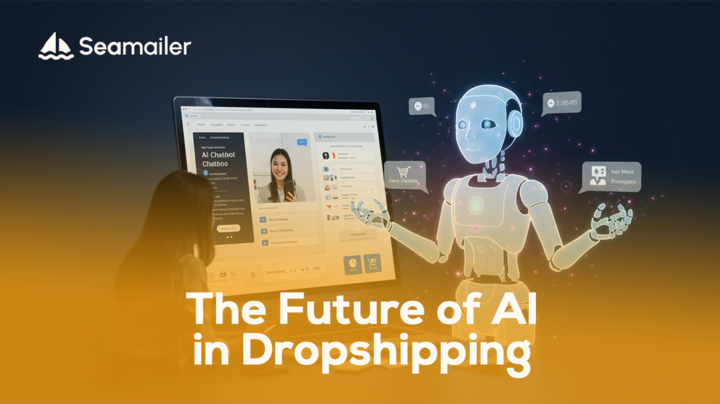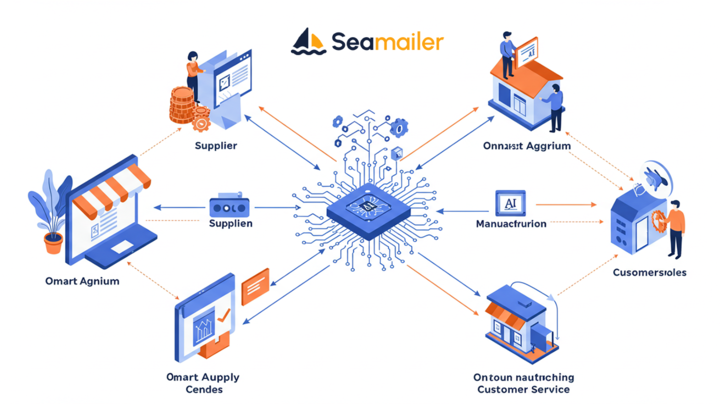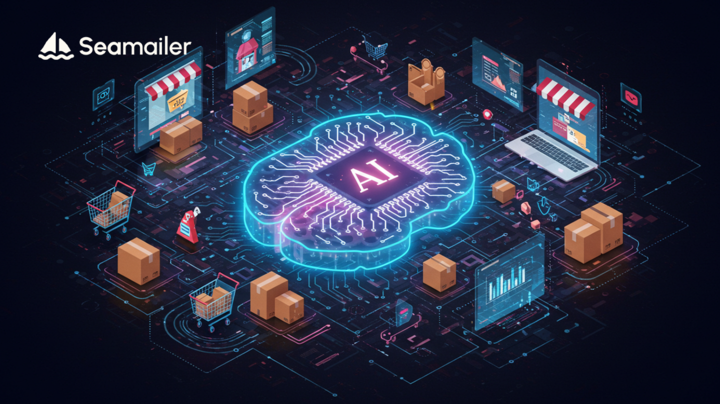The Future of AI in Dropshipping

Automating Product Sourcing & Fulfillment
The global AI market is projected to reach $305.9 billion by 2027, with eCommerce among its fastest-growing sectors (Source). For dropshippers, this technological evolution means faster product sourcing, automated fulfillment, and enhanced customer experiences.
Follow through to know:
- Understanding the Basics of Dropshipping
- The Role of AI in Product Sourcing
- AI-Driven Automation in Order Fulfillment
- Enhancing Customer Experience with AI
- The Future of AI in Dropshipping
- Automated Dropshipping vs. Traditional Dropshipping
- Future Trends and Predictions of AI in Dropshipping
- Applications of AI in e-commerce and dropshipping in the real world
Understanding the Basics of Dropshipping
Dropshipping is a retail fulfillment method that allows you to sell products without holding inventory, relying instead on suppliers to ship products directly to your customers.
In a typical dropshipping setup, as a retailer you list products from your supplier on your online store, and when a customer makes a purchase, you forward the order details to your supplier.
The supplier then ships the product directly to the customer, allowing you to operate without managing physical stock or handling shipping logistics.

The Use of AI in Product Sourcing
Product discovery success is the cornerstone of a profitable dropshipping venture. In the past, it was accomplished by means of hours of manual research. AI has intervened by providing:
1. AI-Driven Product Research Tools
Tools such as Sell The Trend, Niche Scraper, and Ecomhunt utilize AI algorithms to scrutinize product trends on Amazon, AliExpress, and TikTok and they consider factors such as:
- Search volume trends
- Social media engagement
- Competitor analysis
For instance, AI-driven product research tools forecast viral products with 80% accuracy by filtering through thousands of data points of consumer trends and sales histories (Source).
2. Supplier Matching Automation
AI saves the tedious work of finding trustworthy suppliers by:
- Matching dropshippers with pre-vetted suppliers according to fulfillment speed and customer reviews.
- Tracking supplier performance and substituting alternates in case of delays.
- Forecasting price changes to enable businesses to purchase at optimal prices.
- Sites such as AliExpress Dropshipping Center and CJ Dropshipping use AI to suggest suppliers with the fastest shipping times and quality ratings.
AI-Driven Order Fulfillment Automation
AI is simplifying logistics through order fulfillment automation at a quicker and more effective level.
Here's how:
1. AI-Driven Inventory Management
Overselling your products that are out of stock is outdated. AI-driven inventory software such as Syncee and Spocket, Sync with you as supplier in real time for product availability, predict demand surges using predictive analytics and also automatically adjust prices in response to competitor prices and your prices as a supplier.
This provides smooth inventory management, minimizing errors and enhancing fulfillment speed.
2. Automated Order Processing & Routing
AI minimizes human involvement in order processing. When an order is received from a customer:
- The AI solution determines the quickest and most affordable supplier.
- Automatically relays the order information to the supplier.
- Real-time tracking provides precise delivery status information.
For example, AutoDS and Oberlo (Shopify) are software solutions that fully automate this process so that dropshippers can concentrate on growing their business.
3. AI-Driven Shipping & Logistics Optimization
AI-driven logistics technology evaluates shipping data to anticipate probable delays and redirect shipments in accordance, recommend economical shipping options by comparing the prices of carriers and streamline last-mile delivery via intelligent routing.
ShipBob and Deliverr, for example, leverage AI-driven algorithms to save up to 30% on shipping costs while speeding up delivery times.
Enhancing Customer Experience with AI
Besides backend operations, AI is transforming customer experience with:
1. AI Chatbots for 24/7 Support
AI-powered chatbots like Tidio, Chatfuel, and Gorgias provide instant responses to your customers' inquiries, process their complaints, order status, and refunds. Provide personalized product recommendations based on browsing history.
2. AI-Driven Personalization
Personalization is the key in eCommerce. AI enhances your customers’ shopping experience by:
- Displaying dynamic product recommendations (like Amazon's "Customers Also Bought" section).
- Email campaigns automated with AI-driven behavioral triggers.
- Personalized discounts and promotions delivered via predictive analytics.
This level of customization boosts your conversion rates by 30-50%.
The Future of AI in Dropshipping
The coming years will see even more AI-driven advancements, including:
- AI-Powered Visual Search: Customers upload images to find similar products.
- Voice Commerce: Smart assistants processing dropshipping orders.
- Blockchain & AI Integration: Improving supply chain transparency.
- AI-Generated Product Descriptions: Automating content creation for product listings
As AI technology evolves, dropshippers who leverage automation will gain a competitive edge, improving efficiency, customer satisfaction, and profits.
Automated Dropshipping vs. Traditional Dropshipping: Which One is Better for Your Business?
The global dropshipping market size was valued at USD 365.67 billion in 2024 and is projected to grow at a CAGR of 22.0% from 2025 to 2030. But as the business model evolves, automation is transforming how entrepreneurs source, fulfill, and manage orders.
So, is automated dropshipping better than traditional dropshipping? Let’s compare both models to see which one offers higher efficiency, lower costs, and better scalability.
What is Traditional Dropshipping?
Traditional dropshipping is a manual process where store owners:
✅ Find and research products manually
✅ Contact suppliers and negotiate terms
✅ Manually list products on their store
✅ Process orders and forward them to suppliers
✅ Handle customer support without automation
This model works but is time-consuming, error-prone, and hard to scale.
What is Automated Dropshipping?
Automated dropshipping leverages AI and software tools to handle repetitive tasks. Platforms like AutoDS, Dropified, and DSers automate:
✅ Product research and listing
✅ Order fulfillment and tracking
✅ Supplier communication
✅ Inventory updates in real time
✅ Customer service with AI chatbots
The result? Less manual work, fewer errors, and faster order processing.
Key Differences: Automated vs. Traditional Dropshipping
| Feature | Traditional Dropshipping | Automated Dropshipping |
|---|---|---|
| Product Research | Manual research, time-intensive | AI-driven tools analyze market trends instantly |
| Order Fulfillment | Orders forwarded manually | Automated fulfillment, reducing delays |
| Pricing Updates | Manual price adjustments | AI-powered dynamic pricing for competitiveness |
| Customer Support | Manual email/chat responses | AI chatbots provide instant replies 24/7 |
| Inventory Management | Prone to stockouts, requires manual updates | Real-time inventory updates, auto-switching suppliers |
| Scalability | Limited by manual workload | Highly scalable with automation handling operations |
Future Trends and Predictions of AI in Dropshipping
As the e-commerce landscape evolves, the role of artificial intelligence (AI) in dropshipping is set to expand significantly. Here are the key future trends and predictions that will shape this industry:
1. Advanced Predictive Analytics
In the near future, AI will harness predictive analytics to anticipate consumer trends and demand fluctuations. By analyzing historical data and market signals, you as a dropshipper will be able to optimize your product offerings and inventory levels, reducing overstock and stockouts.
2. Personalized Shopping Experiences
AI will enable a new level of personalization in dropshipping. By 2026, we can expect AI algorithms to deliver highly tailored shopping experiences, suggesting products based on individual preferences, past purchases, and browsing behavior, thus increasing conversion rates.
3. Automated Customer Interactions
Customer service will be transformed by AI chatbots and virtual assistants capable of handling inquiries 24/7. By 2027, these systems will become more sophisticated, providing quick resolutions to customer issues and improving overall satisfaction.
4. Dynamic Pricing Models
AI will facilitate dynamic pricing strategies, allowing dropshippers to adjust prices in real time based on competitor pricing, demand, and customer behavior. This adaptability is predicted to enhance profit margins and keep businesses competitive.
5. AI-Driven Market Intelligence
In the coming years, AI will play a crucial role in market intelligence. Dropshippers will use AI tools to analyze competitor activity, consumer preferences, and emerging trends, enabling them to make data-informed decisions and stay ahead of the curve.
6. Sustainable Practices
With growing consumer awareness of environmental issues, AI will help you as a dropshipper adopt sustainable practices. By optimizing supply chain logistics and minimizing waste, AI will support eco-friendly initiatives, appealing to conscious consumers.
7. Augmented Reality (AR) Integration
The integration of AR with AI will enhance product visualization. By 2030, customers will be able to use AR to virtually try on products, which will reduce returns and improve purchase confidence.

Applications of AI in e-commerce and dropshipping in the real world
Here are some well-known brands that are successfully using AI in their dropshipping strategies to achieve remarkable results:
- Amazon: As a pioneer in e-commerce, Amazon utilizes AI in multiple ways to enhance its dropshipping operations. Their recommendation engine analyzes customer behavior and purchase history to suggest products, significantly increasing conversion rates. They also employs machine learning algorithms to optimize pricing dynamically, ensuring competitive pricing while maximizing profit margins. The company has reported substantial increases in sales due to these AI-driven strategies.
- eBay: Uses AI to help sellers optimize their listings and improve visibility. The platform's AI algorithms analyze market trends, customer preferences, and competitor pricing to provide personalized insights for dropshippers. Their "Promoted Listings" feature uses machine learning to optimize ad placements, resulting in higher click-through rates and increased sales for many sellers. Some dropshippers have reported a 30% increase in sales after implementing eBay's AI tools.
- Wayfair: This a leading online home goods retailer that employs AI to enhance product recommendations and improve the customer shopping experience. Their AI algorithms analyze customer interactions and preferences to suggest relevant products. They also use AI for inventory management, predicting demand to ensure optimal stock levels. This approach has led to reduced operational costs and improved customer satisfaction, resulting in increased sales.
- Walmart: They integrates AI into its dropshipping model to optimize supply chain management and inventory control. Their AI-driven system analyzes sales data and predicts demand patterns, allowing them to manage inventory more efficiently. Their use of AI has enabled the company to reduce out-of-stock items significantly, enhancing the shopping experience and increasing overall sales.
- Alibaba: Leverages AI to streamline its dropshipping process for merchants. Their AI-driven platform analyzes vast amounts of data to identify trending products and consumer preferences. By providing dropshippers with insights into high-demand items, they help them make informed decisions that lead to increased sales. Many dropshippers using Alibaba have seen impressive growth by tapping into these data-driven recommendations.
- Shopify: While primarily a platform for creating online stores, they also uses AI to support its merchants. Through tools like Shopify's "Product Recommendations," AI analyzes customer data to suggest relevant products, enhancing the likelihood of upsells and cross-sells. Merchants using Shopify's AI features have reported significant increases in average order value, contributing to overall revenue growth.
- AliExpress: utilizes AI algorithms to analyze vast amounts of user data, helping dropshippers like you identify trending products and optimize their listings. By providing insights into customer preferences, such as color, style, and pricing, they enables dropshippers to tailor their offerings to meet market demand. Many dropshippers sourcing from AliExpress have seen significant increases in conversion rates due to these targeted strategies.
- BigBuy: This is European dropshipping wholesaler, that uses AI to streamline their supply chain and inventory management. Their AI-driven system analyzes your sales data and predicts future demand, ensuring that they have the right products in stock at the right time. This capability has allowed their partners to reduce operational costs and improve delivery times, resulting in enhanced customer satisfaction.
These examples showcase how major brands are effectively integrating AI into their dropshipping strategies, leading to improved operational efficiency, better customer experiences, and significant sales growth.
Conclusion: Is AI the Future of Dropshipping?
AI is no longer optional—it’s the driving force behind modern dropshipping. From intelligent product sourcing to automated fulfillment, AI is optimizing every aspect of the business.
Dropshippers/Entrepreneurs who embrace AI-driven automation will thrive in this rapidly evolving industry. The key is to stay ahead, invest in AI tools, and adapt to emerging trends.
Are you ready to future-proof your dropshipping business? Start integrating AI today and scale your success effortlessly!
